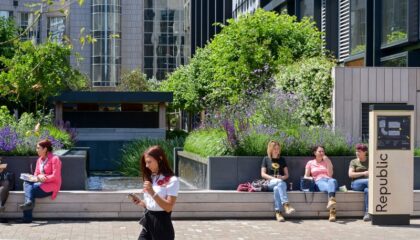Biodiversity isn’t all nature programmes, science lessons and far-flung rainforests – and it’s not just about creating green spaces for the sake of ticking a box. In fact, human survival depends on it. If we want air to breathe, water to drink and food to eat, we must embrace biodiversity: and this begins at home, writes Vicky Cotton in EG.
With over 80% of the UK population living in urban areas, a figure projected to rise to 92% by 2030 (Datastore), the need for city populations to have direct access to nature is becoming all the more crucial, especially when charities like MIND tell us that access to nature directly contributes to people’s mental wellbeing.
Humans rely on trees and shrubs to absorb air pollution in urban areas; not only do plants and trees produce oxygen, they also store carbon by literally sucking it out of the atmosphere. The UN’s Environment Programme discovered that nature can deliver carbon reductions of at least 30% by 2030 if biodiversity is protected and enhanced. However, at the current rate of deforestation 11% increases in greenhouse gas emissions are predicted annually.
Net gains at the heart of developers’ plans
By embracing sustainable practice, the property industry has an opportunity to lead the discussion, working together to ensure the future of UK biodiversity. The need for action is about to transcend tokenism, with the addition of nature to the built environment set to become a national planning requirement. While Biodiversity Net Gain is already part of the National Planning Policy Framework (NPPF), there is no specified percentage for the gain.
Under the forthcoming Environment Bill (currently under consideration by a Public Bill Committee, scheduled to report by 1 December), new developments will be required to enhance biodiversity by a mandatory 10%, a net gain requirement change expected from 2022/2023. This net gain will be required to be maintained for a period of at least 30 years. Aims are far-reaching and include new green spaces and ecosystems intended to deliver improvements in wildlife habitat availability, air quality, water-flow control and outdoor recreation.
Of course, this requirement is already being met or surpassed by several market leaders. Indeed, with a number of local planning authorities looking to achieve improvements of 20%, green initiatives need to be at the heart of developers’ plans. Five years ago, Workman created a biodiversity action plan template across a number of retail parks.
Five-year plans were introduced to promote inclusion of biodiversity and biophilia as key parts of new and existing designs. One element at Telford Forge Retail Park was a living wall created on a car park boundary, where ivy was planted between timber battens, to encourage insect and birdlife. Work has continued with Lockdown One delivering opportunities for site teams to get actively involved, with Central Retail Park at Falkirk providing an example of how unused and possibly neglected corners of properties can be transformed into areas where staff and customers want to spend time.
Nature is “the linchpin of our very existence”
Led by the London Assembly, the capital’s Urban Greening Factor is designed to help the city become greener as it also becomes denser. By 2050 it’s expected that London’s population will have swelled by a further three million, and as we experience hotter, dryer summers and more extreme downpours, a green infrastructure network, planted roofs and walls, street trees, parks and gardens, will help control pollution, reduce flood risk and cool the city.
A prime example of this kind of development is the Urban Nature Project, a project we partnered together with the Natural History Museum, to drive national engagement between people and urban wildlife and the wider natural world. Granted planning permission 28 October, the five-acre space around the iconic museum will be turned into an exemplar of urban wildlife research, conservation and awareness.
In backing the project, Sir David Attenborough spoke of the importance of nurturing wildlife.
“Nature isn’t just nice to have – it’s the linchpin of our very existence, and ventures like the Urban Nature Project help the next generation develop the strong connection with nature that is needed to protect it.”
And this is not limited to open outdoor spaces. Through the Workman Green Spaces challenge, the aim is to add at least one green initiative to every managed asset under our direct management control, and we’re engaging with occupiers across the portfolio to improve each and every property with carbon-consuming greenery: green roofs, beehives, bat boxes, planters, trees, shrubs, wildflower meadows and green walls.
Just like Regal House, an office building in Covent Garden, where we installed a living wall as part of an extensive refurbishment project. It’s providing an extra set of lungs, from which we can all benefit, proving that biodiversity in the urban environment isn’t just a pretty space: it makes a real human difference.
By Vicky Cotton, ESG Director, Workman
Main image: The Natural History Museum has won planning permission to transform its five-acre site in South Kensington as part of its national Urban Nature Project, supported by Workman.
Illustration by Feilden Fowles / J&L Gibbons (c) The Trustees of the Natural History Museum, London.



